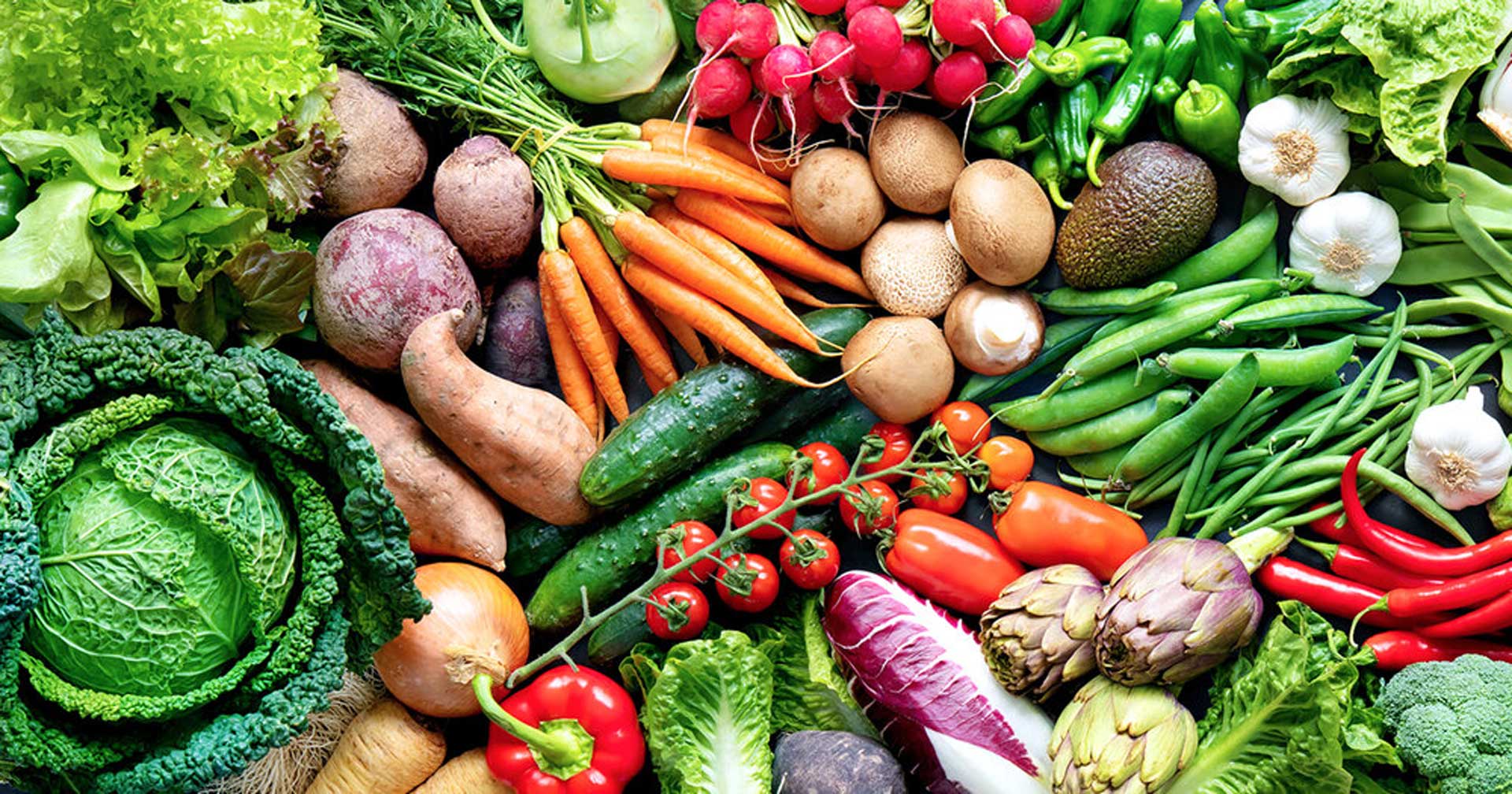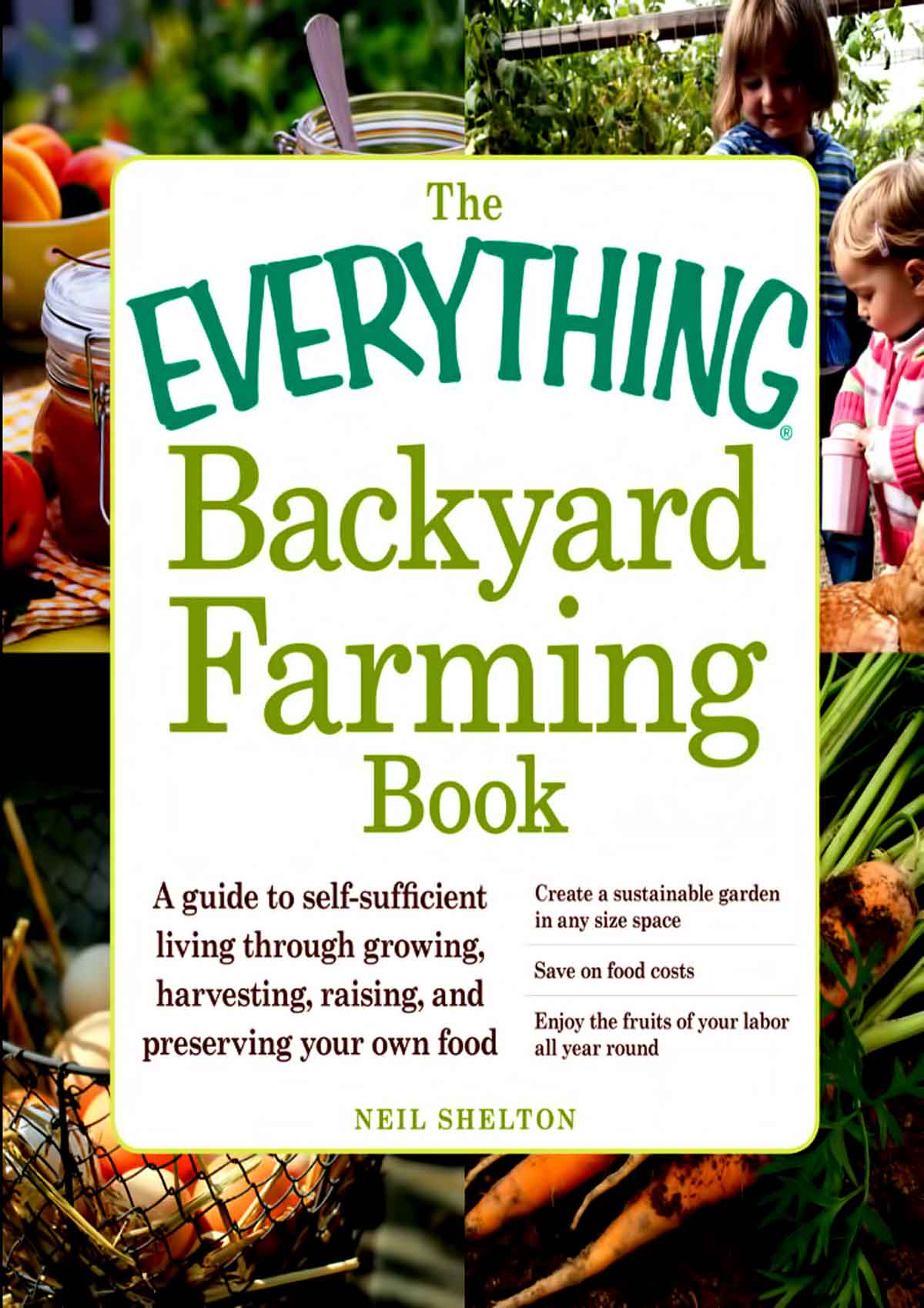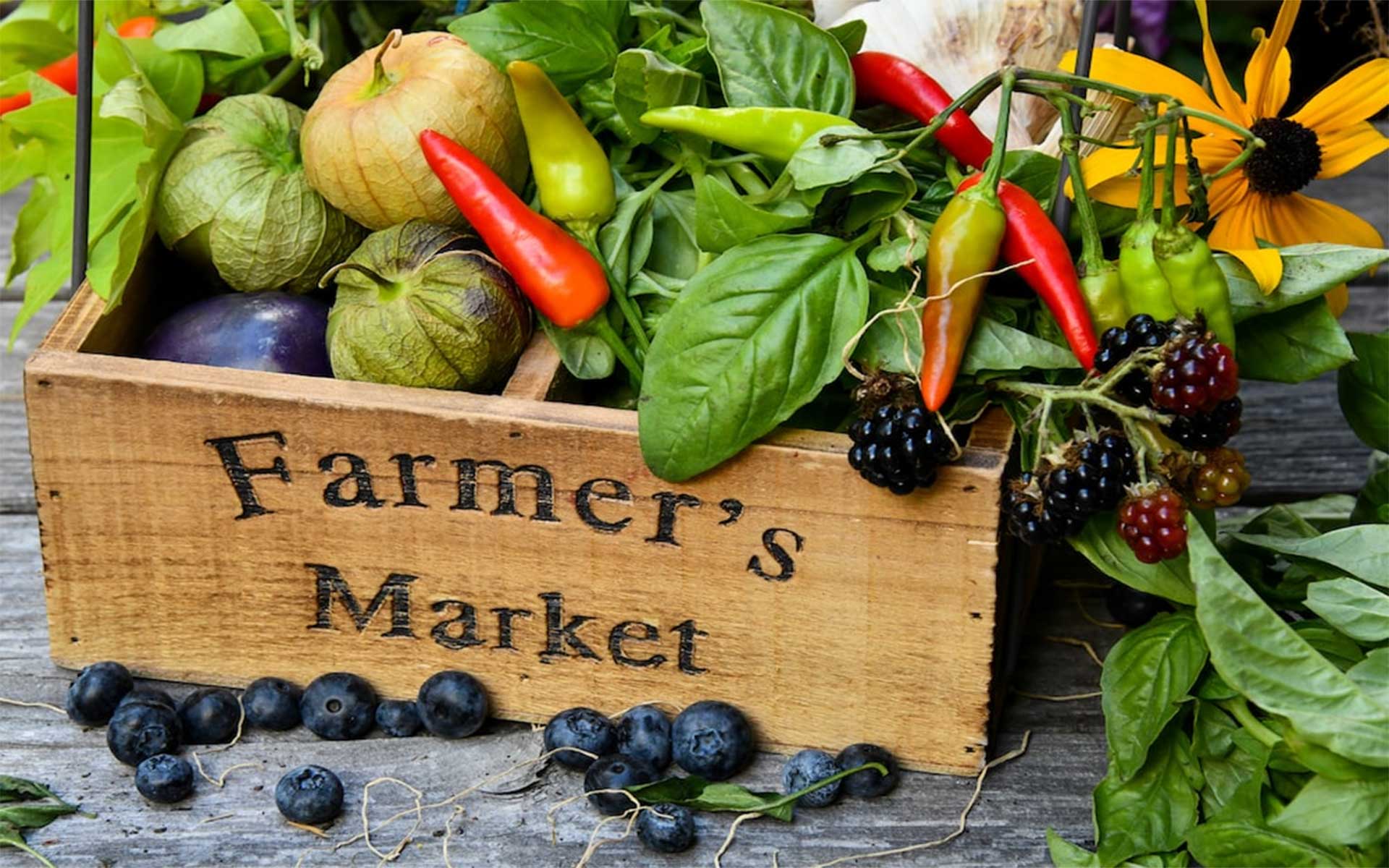

Links

to more

pages

you might find

of interest

Big reasons
to love and support
Farmers Markets
& local produce
With spring, comes a flood of seasonal farmers markets, which means it’s easier for you to access farm-fresh produce.
If you’re wondering why farmers markets may just be the greatest thing to pop up in your neighbourhood this spring, here are 3 big reasons why you should seek out your local farmers market:
1. Fresher Produce:
Farm-fresh produce tends to be seasonal and is more likely to have been recently picked, which means that you’ll be giving your body more nutrition.
Much conventionally-grown produce is picked then sits on a truck, or at a warehouse for weeks at a time before you find it on your local grocery store shelf.
When produce sits for a long period of time, the amount of nutrients in the produce decreases depending on how long it is allowed to sit for before heading to market.
Lastly, farm-fresh produce is more likely to last longer in your refrigerator or on your counter because it’s more recently picked, so you get more longevity out of your fruits and vegetables, which means less frequent trips to the shops.
2. Fewer Pesticides:
Farm-fresh produce grown at smaller farms is less likely to have as many pesticides as conventionally grown produce.
Conventionally grown produce usually has to adhere to certain standards when it comes to not using certain pesticides that are known to be carcinogenic; however, produce that is coming from other countries doesn’t necessarily have to adhere to those standards.
Regardless of where it comes from, fewer pesticides are better for our health, which is one of the major reasons to seek out farm-fresh produce available at your local farmers market.
3. Less Expensive:
One of the most common reasons for people to not purchase organic produce is because of its high cost.
The good news with farm-fresh produce is that it’s less likely to be as costly; it may still be slightly more expensive than conventionally grown produce, but often is competitively priced with commercially-grown produce, and in some cases can be less expensive.
How do I find a farmer’s market?
If you’re unable to get to a farmers market, here’s what you need to know about purchasing organic produce…
There are certain fruits and vegetables that are known to carry more pesticides, often called the “Dirty Dozen”.
If you’re unable to purchase these fruits and vegetables from a locally-grown source, you can seek them out in the organic food aisle.
![]() Apples
Apples
![]() Celery
Celery
![]() Cherry tomatoes
Cherry tomatoes
![]() Cucumbers
Cucumbers
![]() Grapes
Grapes
![]() Hot peppers
Hot peppers
![]() Imported nectarines
Imported nectarines
![]() Peaches
Peaches
![]() Potatoes
Potatoes
![]() Spinach
Spinach
![]() Strawberries
Strawberries
![]() Sweet bell peppers
Sweet bell peppers
![]() Kale/collard greens
Kale/collard greens
![]() Summer squash
Summer squash
If you’re unable to purchase the “Dirty Dozen” either locally or organic, wash them well…
If you’re unable to purchase those fruits and vegetables above that tend to carry more pesticides from either a local or organic source, make sure you wash them well.
Running water and a clean sponge or brush does a great job at cleaning, but so does a basic fruit and vegetable wash made from the following ingredients:
![]() 1 part water
1 part water
![]() 1 part vinegar
1 part vinegar
Note: The best way to use this wash is either to scrub the produce in the wash or to pour the wash over the produce; soaking the produce in the water for a longer period of time can cause some of the nutrients to leech out into the water and be lost when the water is disposed of.
If you have extra space in your yard or at your home…
Plant your own fruits and vegetables, which can help ensure they’re grown without added pesticides. Here’s a list of easy-to-grow fruits and vegetables:
![]() Basil: Grows best in the sun or in a warm environment, and can be grown either in a pot or in the ground.
Basil: Grows best in the sun or in a warm environment, and can be grown either in a pot or in the ground.
![]() Carrots: Grow best in cooler weather, and are one of the easiest vegetables to grow.
Carrots: Grow best in cooler weather, and are one of the easiest vegetables to grow.
![]() Lettuce: Can also be grown in a pot or in the ground and are very easy to grow, as they grow quickly.
Lettuce: Can also be grown in a pot or in the ground and are very easy to grow, as they grow quickly.
![]() Tomatoes: A grow-at-home favorite, tomatoes are also easy to grow and require a warm and sunny place.
Tomatoes: A grow-at-home favorite, tomatoes are also easy to grow and require a warm and sunny place.
![]() Peppers: Similar to tomatoes, they require a warm and sunny place to grow but are relatively easy to grow and are so tasty. They also come in many shapes and sizes.
Peppers: Similar to tomatoes, they require a warm and sunny place to grow but are relatively easy to grow and are so tasty. They also come in many shapes and sizes.
![]() Raspberries: More delicate, but also easy to grow. They like to be grown in a minimally-windy location with plenty of warmth and light.
Raspberries: More delicate, but also easy to grow. They like to be grown in a minimally-windy location with plenty of warmth and light.
![]() Strawberries: A very versatile and easy fruit to grow because they can be grown in a pot, in the garden, or in a hanging basket. They are best planted in April and May and grow nice flowers as well.
Strawberries: A very versatile and easy fruit to grow because they can be grown in a pot, in the garden, or in a hanging basket. They are best planted in April and May and grow nice flowers as well.
![]() Squash: Also easy to grow and grows well in more sheltered locations out of the wind and weather.
Squash: Also easy to grow and grows well in more sheltered locations out of the wind and weather.
![]() Cabbage: Cabbage likes plenty of water and grows best in the spring and fall, and in fact is one of the most frost-resistant plants you can grow, so it does particularly well in colder temperatures.
Cabbage: Cabbage likes plenty of water and grows best in the spring and fall, and in fact is one of the most frost-resistant plants you can grow, so it does particularly well in colder temperatures.
One problem with growing cabbages is that it attracts grey ‘mites’ when grown in a veggie garden – often requiring a lot of pesticide to control, which defeats the purpose of growing organically.
![]() Mint: Can be grown both inside and outside and can even grow all year long. Mint is versatile, can be added to various recipes and has great digestive properties.
Mint: Can be grown both inside and outside and can even grow all year long. Mint is versatile, can be added to various recipes and has great digestive properties.
Farmers’ markets, farm stands, and mobile markets are crucial components to a healthy food system.
They provide outlets for agricultural producers to meet the rising consumer demand for a variety of fresh, affordable, and convenient products grown directly from the farm.
Farmers’ markets offer more than just food, but an experience, entertainment, and the pleasure of meeting your neighbours and community members, making your trip worthwhile.
They are also the perfect way for consumers to fight against the inflation we have all been facing.
The foods at farmers’ markets are fresh and last longer than foods purchased at big box stores and are higher in flavour and nutrition.
It’s a great time to celebrate farmers’ markets and we welcome everyone to come out and find out what they are all about.


Click image above for YouTube Channels or image below for video
10 vegetables
You can regrow from
kitchen scraps to create a
recurring harvest

0:00 Introduction
1:23 Potatoes
2:49 Ginger
4:36 Celery
8:02 Carrot Greens
9:03 Onions and Garlic
13:14 Fennel
14:41 Leafy Greens
16:16 Cabbage
17:45 Beets
18:53 Herbs
21:30 Two Weeks Later
21:40 Sweet Potato Discussion
22:13 Update and Review
Check out this You Tube channel
with over 600 videos from this lady
Click image above for YouTube Channels or image below for video
The TRICK
to saving seeds for next year
Cucumber, Tomato &
Pepper Seed Harvest

Check out this You Tube channel
with over 260 videos from Wilderstead


Click image for video
Raw Milk
some information
What makes Raw Milk
so distinct from pasteurised milk?
Weeks of rich milk have turned this year’s crop of calves into sturdy steers and heifers, grazing alongside their mothers in the tall grass, or finding cool spots at the edge of the woods when the sun gets high.
Various shades of fawn, brown, and black, their coats are satin-sleek, shiny against the deep green forage.
They are the very picture of health.
There is something right about living here, tending these animals and plants, and being rooted in this place.
We have never really been interested in taking vacations to Disneyland anyway, which is a good thing, because people who keep livestock can’t usually go away for long periods.
If you seriously propose to grow your own food, you have to be there to take care of things.
Farmers don’t find it easy to travel.
This time of year that’s no real sacrifice, though. Cooler mornings are good for working in the gardens, and in the heat of the afternoon we might swim in the pond, or pick raspberries at the shady wood’s edge.
When there’s a surplus of milk, we’ll make cheese.
Curds form quickly in hot weather, the probiotic lactobacilli in the milk being most productive when they are warm.
The biological activity of raw milk—it comes from the cow complete with its own array of beneficial biota—is one of the things that make it such an ideal health food. Ironically, that same probiotic energy makes people worry about consuming it.
Is it safe to eat or drink something that ferments so readily?
In fact, doesn’t the USDA warn specifically against consuming raw milk?
Dairy Dangers?
It’s funny that this perfect food has a less-than-perfect reputation. Raw—that is, unprocessed—milk is a controlled substance in most of the fifty United States.
You can’t buy it in the store; in fact, the federal government bans raw milk sales across state lines.
If raw milk is so good for you, why does the USDA issue warnings against drinking it?
Honestly, back when we started milking our own cow, this question really wasn’t on our minds!
The sweet milk we were bringing into the house in buckets every day was delicious, and the children were so glad to have all they wanted to drink.
Our grandfathers, we knew, had kept dairy cows and raised their large families on farm milk, and we intended to do the same.
Pretty often, though, we encountered people or opinions that were adamantly opposed to our plans.
We discovered that in the state of Ohio, if raw milk was consumed in our house, we were supposed to have a sign, prominently displayed, warning people of this dangerous practice.
Yes, really!
We knew that medical professionals looked with disapproval on raw milk being given to children.
Even some friends and family voiced concern over what they considered an unnecessary risk for our family.
All this over a food that had been in the human diet for thousands of years! How could there be such a difference of opinion?
All Milk is Not Equal
Historically, human beings have been consuming raw milk since the domestication of the first ruminants.
Back then there were no stainless steel buckets or microfiber filters; our great-great-greats stored milk in vessels of wood, clay, or even hide. They weren’t worried about germs, but they knew how to use milk in dozens of delicious ways to feed their families year-round, with every stage of fermentation having its appropriate uses.
Generation after generation grew up drinking milk, and nothing but good came of it.
So why does the USDA ban the stuff?
Well, a lot has changed in the past couple of centuries, including the ways we keep, feed, and milk dairy cows.
Big modern cities require food to be shipped from farther than ever before.
Dairies may be literally a thousand times bigger than they used to be.
To produce so much milk and ship it long distances, we’ve turned to mechanization.
Today milk is moved by pipeline, stored and shipped in enormous tanks, and sits on supermarket shelves for days or weeks.
All of the large-scale systems used for this work are in near-constant use: when cows are being milked two or three times a day, you can’t take apart all the equipment between milkings and give it a good scrubbing.
Instead, it is flushed with
caustic chemicals and very hot water
to kill residual bacteria.
But this doesn’t always work.
Biofilms inside milking equipment can be home to pathogenic biota—’bad bugs,’ like listeria, campylobacter, and E.coli.
Even if these critters didn’t make you sick, they would ferment your milk, ‘spoil’ it, before you had a chance to drink it.
This is why store-bought milk is pasteurized, and the same story explains why our home-produced, home-consumed milk doesn’t need to be.
When the USDA warns against drinking raw milk, they aren’t talking about ours.
Actually, clean raw milk
from a cow that eats the food
God intended for her – grass –
is one of the most perfect foods
in the world.
Think about it: milk is the sole food God created to feed His baby mammals, new life to be nourished by their mothers’ dedicated and loving care.
Milk’s nutritional profile makes it a whole food; its naturally present probiotics make it a health food, too.
So it’s no wonder one of our favorite things about keeping a family cow is all the wonderful milk it makes available on the family table.
We drink gallons of milk every day, and dairy products like cheese, butter, yogurt, and sour cream feature largely in every meal.
And while it is delicious, milk isn’t just a food for us; it’s a health regimen.
Work of Our Hands
Milking time is a quiet, peaceful time on our farm.
The cows go willingly into the stanchions.
If we are offering a treat of hay or kelp, they tuck in.
We scoot our stools up close; with the zing of milk into the bucket, the sweet smell of fresh milk rises into the air.
There’s plenty of time to think.
Why do we choose to live this way?
One reason, and a very real one, might be that it just feels right.
When we sit down to milk our cows, we’re continuing a line of human endeavor that has blessed people for thousands of years, and we’re using the same tools, the same methods folks have always used, because they work.
We don’t need anyone’s permission.
We don’t need electricity or fuel.
Just us, the cow, and a few moments of peace.
We’re grateful that God has made things this simple

Controversial take:
Lactose intolerance doesn't exist
It is instead pasteurization
and homogenization intolerance
in 99% of cases with very very
few exceptions.
The current mainstream argument you often hear about why humans shouldn't be drinking milk, is that we don't have a gene for the production of lactase and/or lose it after we are infants off of breast feeding, and I'm here to tell you that the gene is not responsible for your digestive systems ability to digest lactose and is just an adaptation found in some ancestral lineages.
It's the bacteria in your gut that does the digesting of lactose, which is coincidentally present in raw dairy in large quantities, especially fermented dairy like kefir.
This same bacteria is present in breast milk because it is raw and facilitates the digestion of lactose, and it's the same for raw dairy from any animal, which all contain lactobacilli and other strains that digest the lactose for you and create the enzymes like lactase.
Pasteurized milk does not have this bacteria due to it being killed by heat, which the government argues is "for your safety", when in reality it's more for the extension of shelf life and profitability, as well as ensuring the large dairy producer middle man doing the pasteurization is getting their cut of the profits that they've invested a lot of money in lobbying for.
Raw milk is direct from farmer to consumer and cuts them out entirely, so obviously it's in their best interest to bribe the FDA and regulatory officials to say it's unsafe, going after small farmers like the Amish for trying to sell it.
As for why some people get the runs with dairy from the store, some of that is due to the lack of good bacteria to digest lactose, but it's also because of homogenization of fats making them very harsh on your gut and indigestible, making your body want to void it immediately.
Not only does raw dairy have the essential bacteria for digestion and clean fats, but it also has various components like lactoferrin and lactoperoxidase that ensure only healthy bacteria remain, mucin and oligosaccharides that protect the strength of the gut lining and prevent permeability, various immunological components that support your immune system being strong and resilient, along with lactoglubins and other cofactors that are responsible for carrying fat soluble vitamins and other nutrients for proper absorption.
When you heat milk over a certain temperature, much of the good stuff that makes it healthy is destroyed, altering it's digestibility, ruining it's immunological benefit, making the calcium much less bioavailable and likely inflammatory, and not providing any probiotic benefit to strengthen the gut, which is the root of A LOT of disease.
Anyone that tells you human beings aren't supposed to drink milk or that they're lactose intolerant, please share with them the presentation in the comments and tell them to find some raw dairy with the milk finder.
It's the most gut healing food on earth and will radically improve your health, especially if you ferment it into something like kefir, yogurt, or cheese from a raw state."

click image for link to article
A BRIEF HISTORY OF DAIRY:
HOW MILK GOT A RAW DEAL
Simple - because when milk first became popular people
kept their own cows and the sanitary conditions
they was kept in was unknown along with
any control over what the milk-producing cows at
It wasn’t the milk that was the problem
It was the unregulated and possibly
unsanitary environment it came from
All raw milk was different.
This is no longer the case and
everyone should consider consuming
raw milk
![]() Check out
Check out
'The brief History of Dairy'
HERE
-0-0-0-0-
Raw milk wasn’t banned for your health
it was targeted by the Rockefellers in the 1900s
to crush small dairy farms and
boost their dairy empire profits.
Power, not safety, pasteurized the industry.


click image for link to article
about raw milk

![]() Raw milk is nutrient dense - It’s a great source of calcium, iron, Vitamins A, D & K, phosphorus, zinc, conjugated linoleic acid (CLA), and omega-3 fatty acids, plus many beneficial enzymes and probiotics that are healthy bacteria able to inhibit the growth of undesirable and dangerous organisms in the gut.
Raw milk is nutrient dense - It’s a great source of calcium, iron, Vitamins A, D & K, phosphorus, zinc, conjugated linoleic acid (CLA), and omega-3 fatty acids, plus many beneficial enzymes and probiotics that are healthy bacteria able to inhibit the growth of undesirable and dangerous organisms in the gut.
![]() Raw milk is self digesting - It has all of the enzymes it needs to be digested by humans. If you are lactose intolerant, that means you’re lacking lactase, the enzyme necessary for lactose (the sugar found in milk) breakdown. Raw milk contains lactase! If you enjoy milk and have been avoiding it for this reason, you may find that you are able to have raw dairy products without complication.
Raw milk is self digesting - It has all of the enzymes it needs to be digested by humans. If you are lactose intolerant, that means you’re lacking lactase, the enzyme necessary for lactose (the sugar found in milk) breakdown. Raw milk contains lactase! If you enjoy milk and have been avoiding it for this reason, you may find that you are able to have raw dairy products without complication.
![]() Raw milk is immune-boosting - It contains immunoglobulins, specifically IgG, that support immune function. In fact, there are multiple studies that have shown raw milk consumption is correlated with improved immune system function. Raw milk has also been correlated with reduced risk of respiratory infections and fevers, as well as reduced risk of asthma and allergies.
Raw milk is immune-boosting - It contains immunoglobulins, specifically IgG, that support immune function. In fact, there are multiple studies that have shown raw milk consumption is correlated with improved immune system function. Raw milk has also been correlated with reduced risk of respiratory infections and fevers, as well as reduced risk of asthma and allergies.
![]() Raw milk has a rich history in healing - Since ancient times, physicians like Hippocrates, Galen, Pliny and Varro have used raw milk to cure a wide range of diseases. Hippocrates advised tuberculosis sufferers to drink raw milk in quantity. In the Ayurvedic medicine of India, milk is used in the practice of brimhana meaning to “buck up” or nourish the body. It’s also used in rasayana to rejuvenate the body and in vajikarana, to promote sexual function and fertility. Physicians prescribed raw milk as a gentle laxative, to cool inflammation of ulcerated tissues, and as a galactagogue to increase milk production for the nursing mother.
Raw milk has a rich history in healing - Since ancient times, physicians like Hippocrates, Galen, Pliny and Varro have used raw milk to cure a wide range of diseases. Hippocrates advised tuberculosis sufferers to drink raw milk in quantity. In the Ayurvedic medicine of India, milk is used in the practice of brimhana meaning to “buck up” or nourish the body. It’s also used in rasayana to rejuvenate the body and in vajikarana, to promote sexual function and fertility. Physicians prescribed raw milk as a gentle laxative, to cool inflammation of ulcerated tissues, and as a galactagogue to increase milk production for the nursing mother.
![]() In the U.S., raw milk was used for one hundred fifty years to treat a wide range of conditions and is still used today in some hospitals in European and other countries.
In the U.S., raw milk was used for one hundred fifty years to treat a wide range of conditions and is still used today in some hospitals in European and other countries.
Ever since the Industrial Revolution, we’ve been lead to believe that raw milk is unsanitary and unsafe for drinking.
With an open and curious mind,
you will come to find that is not the truth.

click image for link to article
Raw milk vs Pasteurized
the whole story
![]() Check out
Check out
'Raw milk vs Pasteurized'
HERE
![]() Check out
Check out
'7 reasons to drink Raw milk'
HERE

click image for link to article
The Raw Truth About Milk
by William Campbell Douglass.pdf
Why was milk
pasteurised in the first place
full article.

click image for link to article
Why grass-fed milk is better

click image for link to article
The on skim milk

click image for link to article
7 reasons to drink raw milk
and 2 reasons not to


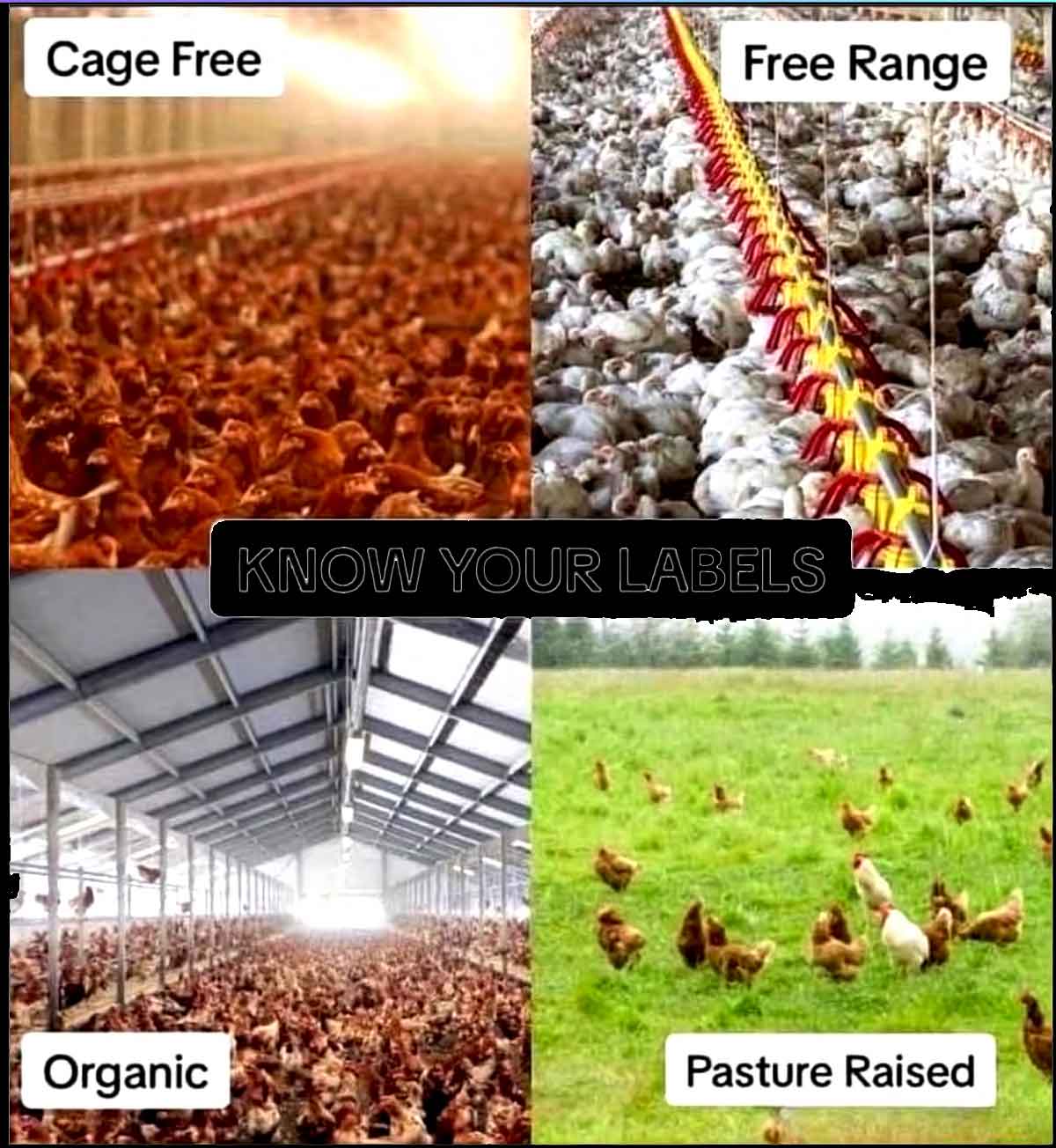

EGGS
some information

click image for video
How to TEST
for
FRESH EGGS
click image for link to article
EGGS
(Australia)
click image for link to article
What are
ORGANIC EGGS
(Australia)
click image for link to article
What are
FREE-
RANGE EGGS
(Australia)
click image for link to article
What are
the
healthiest EGGS
(USA)
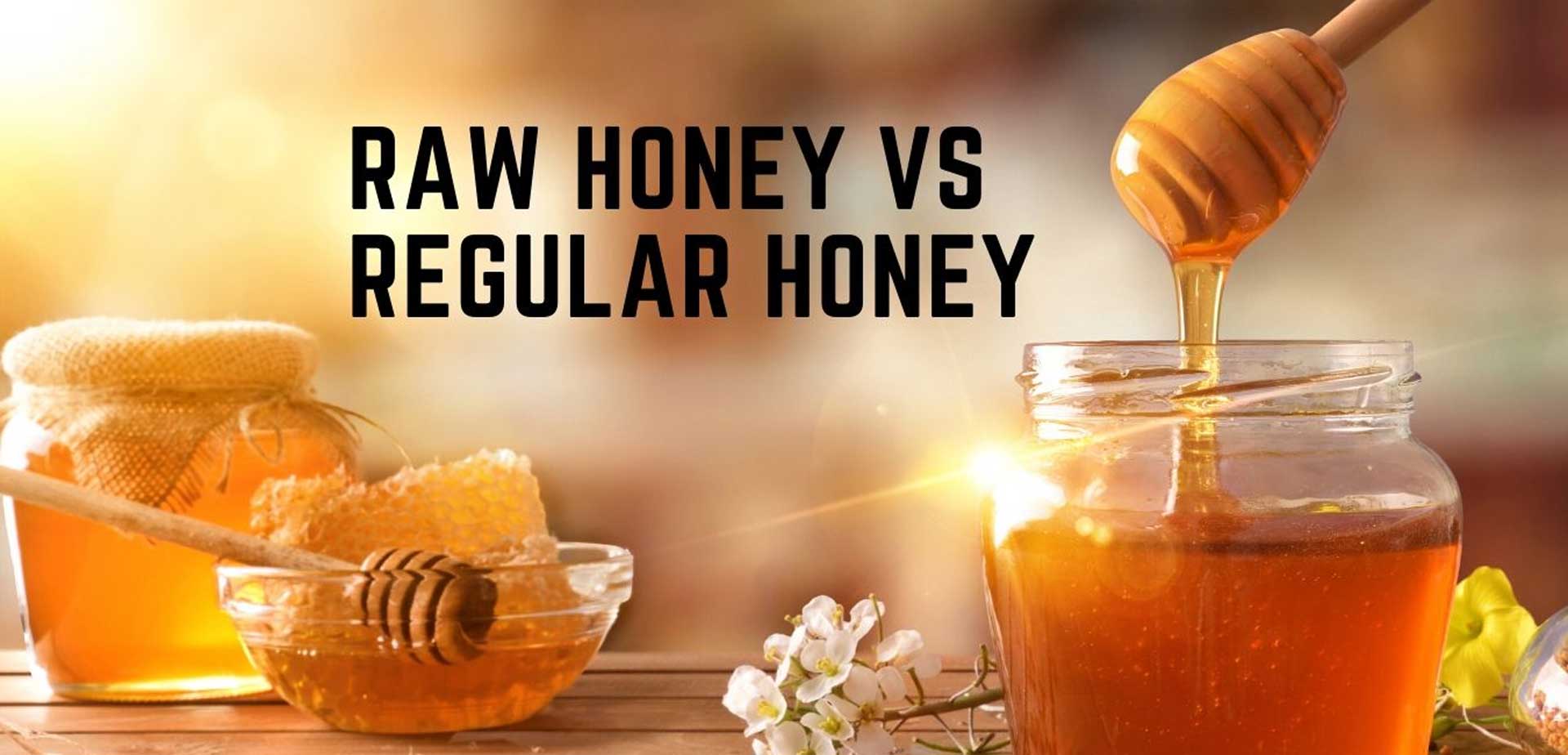

HONEY
some information
What makes Raw Honey
so distinct from Regular Honey?
Honey is a naturally sweet liquid that bees make in a honeycomb that has live enzymes and antioxidants.
The role of the honey bee in making honey is unimaginable.
Here is the main difference between raw honey vs regular honey.
Honey, as it is present in the honeycomb and extracted in a hygienic manner, is RAW HONEY.
In the olden days, people had the chance to charmingly taste the raw honey directly from the beehives. Wow! it was a wonderful moment though.
When people slowly found that the honey market is large and open to profit earning tactics.
Then the regular honey took birth with the motive of profit.
Let’s dive in to know the Regular Honey?
Regular Honey or processed honey is honey that is commonly available in the market, It has undergone high heat and ultra-filtration to make it smooth and shiny.
This nature of honey largely appeals to many customers in the market.
One more risk regular honey carries are – it might be adulterated with synthetic honey HFCS or Rice syrup.
How does Raw Honey look like?
When honey is extracted from the honeycomb, honey has bee pollen and live enzymes.
As a result, Raw Honey looks cloudy and blurred than the processed honey.
How are they different?
Raw Honey varies with its taste, aroma and texture, as a result of honeybee taking nectar from different flowers.
Our world is blessed to have a large region of forest and jungle where honeybees forage for pollination.
On the other hand, regular honey is uniform in taste, aroma and texture.
It is far away from the tag of pure honey.
Honey loses its sheen and natural properties after heating at a high temperature due to the process called pasteurization.
Why is Raw Honey expensive?
During bulk production of honey, honey is usually extracted in unripe conditions.
Unripe honey has a high moisture level hence it tends to spoil by fermentation.
It becomes obligatory to process honey with high heat to remove moisture.
This increases shelf life.
Raw honey is procured directly from the source in a ripe condition. Honey ripened in honeycomb does require processing therefore, it sets out in the market without high heating and ultrafiltration.
So the careful selection of ripe honey makes the availability of Raw Honey difficult and expensive.
Is Raw Honey Safe?
Raw honey is absolutely safe except for children with the age bracket of one year or below.
This is because Raw Honey may contain spores of bacteria ‘Clostridium botulinum’ which is harmful and causes food poisoning in children.
Though not every honey contains these spores of bacteria for the safe side doctors advise not to consume honey by infants below one year of age.
In fact, in many traditions, honey is tasted to newborn infants but we don’t hear any bad news related to the baby falling sick because of honey.
Anyone above one year can very well combat the spores and does not fall sick even the raw honey contains Clostridium botulinum spores.
How to store Raw Honey?
Storing Raw honey is very crucial else it may become unusable.
1. For longevity, the best way is to store it in glass, stainless steel or earthen pot.
2. The bottle or vessel in which honey is stored should be airtight. Otherwise, it may get fermented.
3. It should be exposed to RH (Relative humidity) above 48% otherwise it may imbibe water and the top layer get fermented. thereby spoiling honey.
How beneficial is Raw Honey?
Raw Honey has incredible health benefits.
It contains many beneficial nutrients like vitamins and minerals which are crucial for health.
Furthermore, it also contains live enzymes and antioxidants which lower the risk of inflammation, heart and cancer diseases.
On the contrary, regular honey doesn’t include these properties in it.
All these properties lose their value when we heat honey at a high temperature and ultra-filter it.
Where to get the Raw Honey?
The best way to get the Raw Honey will be from your local supplier or from the farmer. Or search for small brands which have access to the source of honey.
How to judge Raw Honey and Regular Honey?
In today’s time and age people judge Raw Honey with the conventional outdated method.
As substances like invert sugar, high fructose corn syrup HFCS and Chinese rice syrup behaves like honey when tested with conventional methods.
Using the conventional method to detect the adulterants in regular honey sold in the market now is highly impossible.
Because it only examines the physical nature of honey, but not its innate properties.
There is one way you can verify Raw Honey by checking if that brand is selling varieties in honey.
As an illustration, only the genuine brand can sell varieties in honey but not synthetic brands.
Difference between Raw honey and organic honey?
‘We extract organic honey from organically certified areas.’
Though it may sound good it is all a commercial gimmick.
The quantity of organic certified honey sold in the market nowadays is far high than in the organically certified area.
Organic honey can be at the risk of processing. If processed even organic honey comes in line with regular honey as it can not be identified easily.
Whereas raw honey has a distinct natural aroma and bee pollen content and the presence of its live enzymes is highly beneficial for human health.
Conclusion
Be wise and educate yourself in judging the Raw Honey yourself in the market.
This ancient food will surely provide you with a lot of health benefits and saves your hospital bills.


RAW HONEY
some information
DIGESTIVE HEALTH
Raw honey has been shown to be an effective prebiotic, meaning that it nourishes the essential good bacteria that populate our digestive system (Eteraf-Oskouei & Najafi, 2012).
It is the type of complex sugars in honey known as fructooligosaccarides that helps the good gut bacteria grow (Roberfroid et al, 2010). An Australian study recently showed that honey was as effective as the commercial prebiotic ‘Inulin’ (Cokcetin, 2015).
Not only does honey support the growth of good bacteria but it can also kill bad bacteria and therefore has been shown to be effective in correcting digestive bacterial balance (Cokcetin, 2015).
Healthy bacterial balance in the gut has long been linked to good overall health but has more recently come into the spotlight – and it is fascinating (for me anyway!).
New research shows that there is a direct connection between the balance of good bacteria and the health of the brain, called the gut-brain-connection (Burnet, 2012).
It has been proven that high levels of good bacteria has a beneficial impact on mood, anxiety, capacity to problem solve and memory, as well as assist in the treatment of epilepsy (Burnet, 2012).
Not all questions as to how this works have been answered, but it is certainly an exciting area of research.

ANTIOXIDANT
Honey is a good source of antioxidants, meaning consumption of honey assists in the destruction of free radicals – the compounds that accelerate ageing and disease.
One study found that honey can have approximately 0.79 – 1.71mg of antioxidants per gram of honey (variable depending on the type of flowers the bees foraged from) (Schramm et al, 2003).
This study found that by consuming honey in place of other sweeteners (artificial or natural) can protect the body against oxidative stress (Schramm et al, 2003).
ANTIBACTERIAL
Raw honey contains vitamins, minerals, proteins and phytochemicals like hydrogen peroxide which works to give honey its amazing antibacterial properties (Alvarex-Suarex et al, 2010).
Historically honey was used as a medicine amongst the Ancient Egyptians, Chinese, Greeks and Romans for wound healing and to prevent the spread of infections such as digestive and/or skin diseases (Eteraf-Oskouei & Najafi, 2012).
Across the world at the moment, honey and other natural antibacterials are again being recognised as viable weapons in medicine -specifically in the fight against antibiotic resistance (Irish et al, 2011).
Using honey in medicine is called Apitherapy and is in instances where disease causing pathogens are not responding to conventional medicines/antibiotics.
For healthy individuals honey has been shown to reduce the number and spread of common bad bacteria’s in the digestive system from minor pathogens to the real nasties including E-Coli (causes diarrhoea, urinary tract infections and septicaemia) and salmonella to name just a few (Mandal & Mandal, 2011).

Note:
Do not cease a course of antibiotics without consulting your doctor. Apitherapy should be used in consultation with a health professional.
Another way that the antibacterial properties of honey have been put to use throughout history is in ‘wound healing’, where it is applied as a liquid bandage over a wound which not only prevents bacteria and other nasties from infecting the wound but also kills those that are already there.
How honey works to heal a wound:
The enzymes in the honey draws moisture away from the wound to dehydrate the bacteria and limit its spread (Alvarex-Suarez et al, 2010).
-
The sugar content of the honey makes a sticky protective barrier which nasties (bacteria, virus and other microbes) cannot get through (Mandal & Mandal, 2011)..
-
The sugar content and acidity of honey give it antiseptic properties – meaning it kills bacteria it is in contact with (Irish et al, 2011).
-
The anti-inflammatory properties of honey speed up tissue repair. By reducing the inflammation at the wound site the tissue is able to focus on repair rather than preventing infection (Alvarex-Suarez et al, 2010).

WHY RAW?
The intricate chemistry giving honey these incredible qualities can be destroyed when exposed to heat and therefore to attain these benefits it is important to purchase raw, untreated honey.
Many companies heat their honey to prevent crystallisation – which is where the honey goes slightly solid. Nectar Honey is not heat treated or blended and it is as fresh from the hive as possible.
Although raw honey may crystallise – which can be reversed through gentle immersion in warm water – the benefits it gives you is far superior to that of mass market pasteurised honeys.
click image for video
Food Industry
some disturbing secrets
Maybe you’re not getting
the healthy food you think
you’re paying for!
I tried the honey test – it works!!

Did you know that one of the first coins in the world had a bee symbol on them?
Did you know that there are live enzymes in honey?
Did you know that in contact with metal spoon these enzymes die? The best way to eat honey is with wooden spoon, if you can’t find one, use plastic.
Did you know that honey contains a substance that helps your brain work better?
Did you know that honey is one of the rare foods on earth that alone can sustain human life?
One spoon of honey is enough to sustain human life for 24 hours
Did you know that propolis that bees produce is one of the most powerful natural ANTIBIOTICS?
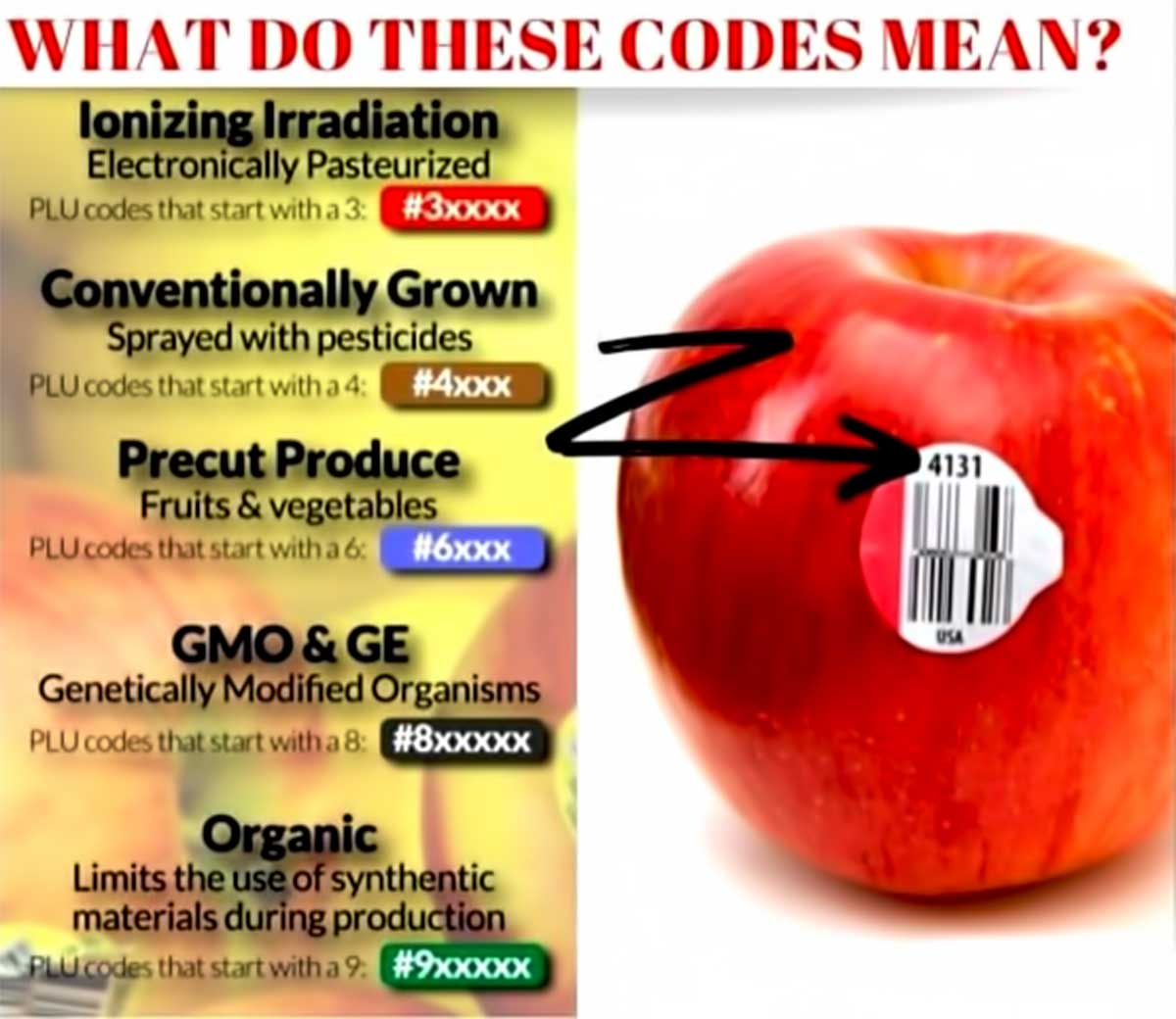



click image for video
GROW IT ALL YOURSELF
Electroculture
breaking up the Chemtrails
During the resets from (1900s to 1940s)
They removed the fractal antennas
from the old world buildings
because they balanced out the atmosphere.
Thankfully with electro culture
we can bring that back!

click image for video
Electroculture
Gardening Techniques
for Beginners
Elevate your garden
What is Electroculture?
Electroculture is the an ancient practice of increasing yields utilizing certain materials to harvest the earth’s atmospheric energy.
This energy is always present and all around us also known as Chi, Prana, Life force, and Aether.
When using electroculture there is no need for the use of pesticides, manure, or fertilizers.
This is primarily why this information was suppressed.
All you need is the sun, the clouds, the rain, the nitrogen in the air, and the ability to harness atmospheric energy.
These atmospheric antennas can be created from materials such as wood, copper, zinc, and brass.
When adding these atmospheric antennas to your garden, soil, or farm they will amplify your yields, combat frost and excessive heat, reduce irrigation, reduce pests, and increase the magnetism of your soil leading to more nutrients in the long run.
How do I make an electroculture antenna?
Atmospheric antennas can be made out of wood dowels found at Home Depot, or a local piece of wood from your backyard.
The taller you make the antenna the larger your plants will grow. Justin Christofleua recommended 20 feet+, but any height will do.
You can wrap the wood dowel or local wood with copper & zinc wiring making a fibonacci spiral or vortex up in the air facing Magnetic North.
The combination of zinc and copper can work like a battery when the sun hits the the antenna.
You will then place this antenna about 6-8 inches into your soil and let Mother Nature do the magic.
Get creative, try different designs, and you will see the true potential of electroculture.
Can I just use a copper pipe instead of making an antenna?
You can use a copper pipe, but the best results coming from copper coils.
The copper coil harness the flow of energy.
Does electroculture work on indoor plants or potted plants?
Electroculture works wonderfully on indoor plants! A simple chopstick can be used to create your indoor antenna.

Instead of creating an electroculture antenna can I just wrap my plants in copper?
The issue with wrapping plants in copper is not all plants enjoy being entangled.
It is best to make a simple antenna and place it near the plants you want to help.
How tall should the electroculture antenna be?
You can make your atmospheric antennas as tall as you like.
On average the best antennas are 6 feet+ to gather more atmospheric energy.
How much square footage does an electroculture antenna cover?
On average, one 6 foot antenna can cover about about 225 sqft.
Which direction should I make my electroculture antenna?
If you live in the Northern hemisphere you can wind your antenna clockwise.
If you live in the Southern hemisphere you can wind your antenna Counter-Clockwise.
Where can I find copper wire for electroculture?
You can find copper wire at any hardware store.
Does the copper thickness matter for electroculture?
Any thickness of copper wiring will work, but if you would like you can always use a heavier gauge.
Copper Gardening tools versus Iron Gardening tools: What we were never told
When Victor schauburger was studying agriculture he noticed Copper/Brass/bronze tools would not impact the magnetism of the soil like those made of Iron.
Iron tools decreased the magnetism of the soil, made the farmers work harder, and caused drought like conditions.
While on the other hand copper/brass/bronze tools did not alter the magnetism of the soil, lead to high quality soil, and required less work when used.
When Victor showed this to the local council they said his work would impact their profits on the fertilizer they are promoting.
They decided to petition against him with the help of the local media to inform farmers they would yield too much food and it would lead to less money in their pocket.
The farmers went against Victor’s work and this knowledge was lost in the 1950s.
It is also noted that slugs only come around when high amounts of iron are present in the soil to clean up the mess their antennas are picking up.
When using copper tools or atmospheric antennas the slugs disappear.
Some interesting findings of Justin Christofleua* on electroculture plant growth:
- In fields in which were not manured or irrigated Oats grew upwards to 7 feet+
- Potatoes grown in the same condition 6 feet 3inches high, carrying 30 to 35 tubers, and weighed 1 to 2 pounds per potato.
- Grape vineyards impacted by Phlyloxera were healed and rejuvenated. The grapes ended up sweeter and had a much richer flavor.
- Carrots grew to the lengths of 19 inches, beetroots to 18inches, and nearly 17 inches in circumference.
- An old pear tree which had hardly any bark left was fully rejuvenated by electroculture and started producing pears of up to 1 pound each.
* All without the use of manure, pesticides, or fertilizer just the atmospheric energy, magnetism and telluric currents of the earth.
A simple solution to solving the shortages we are all facing.
click image for video
ELECTROCULTURE:
HOW TO SIMPLIFIED!
click image for video
ELECTROCULTURE:
FRACTAL ELECTROCULTURE ANTENNA!
click image for video
Electroculture
a lost farming technology
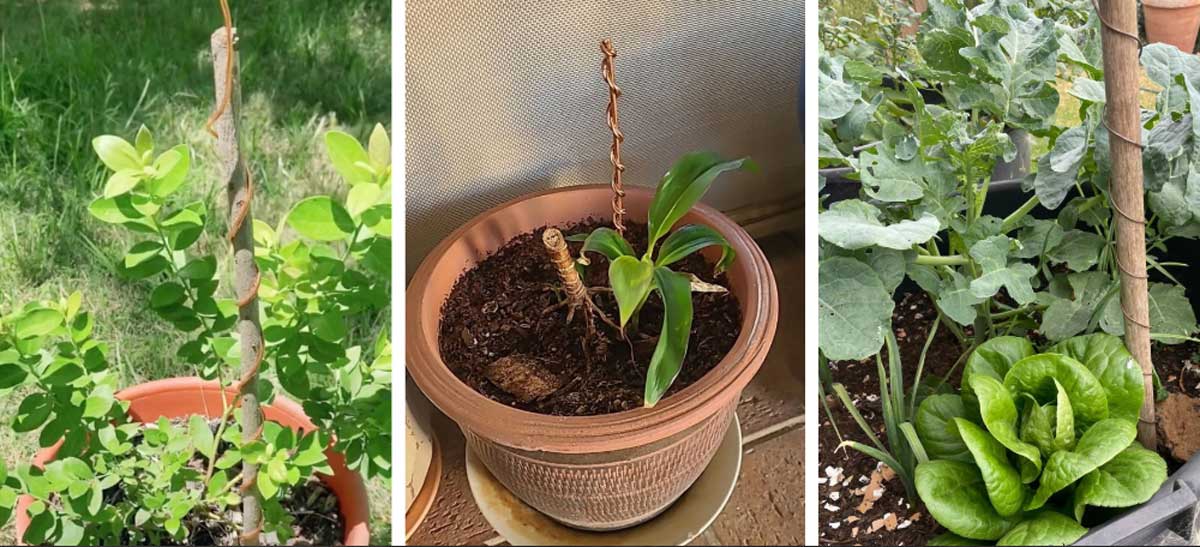
click image for video
Probably, when the Earth
was being created it
didn't include visits to
the local hardware store for
any chemical or fertilisers
to make it happen.
When using the
natural (nature's) energy
of electroculture
there is no need for
the use of pesticides,
manure, or fertilizers.
A cynical person might assume
this is primarily why electroculture
information was suppressed.
All you need is the sun, the clouds, the rain,
the nitrogen in the air, and the ability
to harness the abundant energy from
the atmosphere Earth's (Gaia).
Atmospheric antennas to harness and direct
this energy can be easily created from
materials such as wood, copper, zinc, and brass.
When adding these atmospheric antennas to your garden,
soil, or farm they will amplify your yields,
combat frost and excessive heat, reduce irrigation,
reduce pests, and increase the magnetism of your soil
leading to more nutrients in the long run.
It's generally assumed 'bigger is better'
and that the taller you make the antenna
the larger your plants will grow.
This may or may not be the case as
examples further down this page
might illustrate.
The name of the game is to experiment
and ANY antenna you create will be
better than none.
They only take minutes to make
and don't have to cost much, (if anything
if you already have some old cables (wires)
laying around in your shed doing nothing).

click button to follow link to PDF
Electro Horticulture
(PDF)

click image to follow link to article
My Electro Culture
effort
(so far)
Nothing technical here ...
... just a few pics I took
October 1 2023
If you don't measure,
you can't manage.
I've been experimenting with different size
'electro-sticks' with different size construction.
Seems, bigger isn't necessarily better.
I put a volt-meter into the soil
and onto the coil -
and got some varying readings.
In most cases the smaller and narrower 'sticks
gave better reading in the pots.
But ... IMO these thing should be placed
in Earth's 'ground' - this is where the
energy is.
I'm not an electrician so, likely,
I'll get called out by those who
do know how to do this properly
as some kind of a 'dunce'
for doing it this way.
if I've got it wrong
and anyone wants to let me
know how to do it properly
message me (below).


Readings fairly consistent
even for different size 'sticks'.
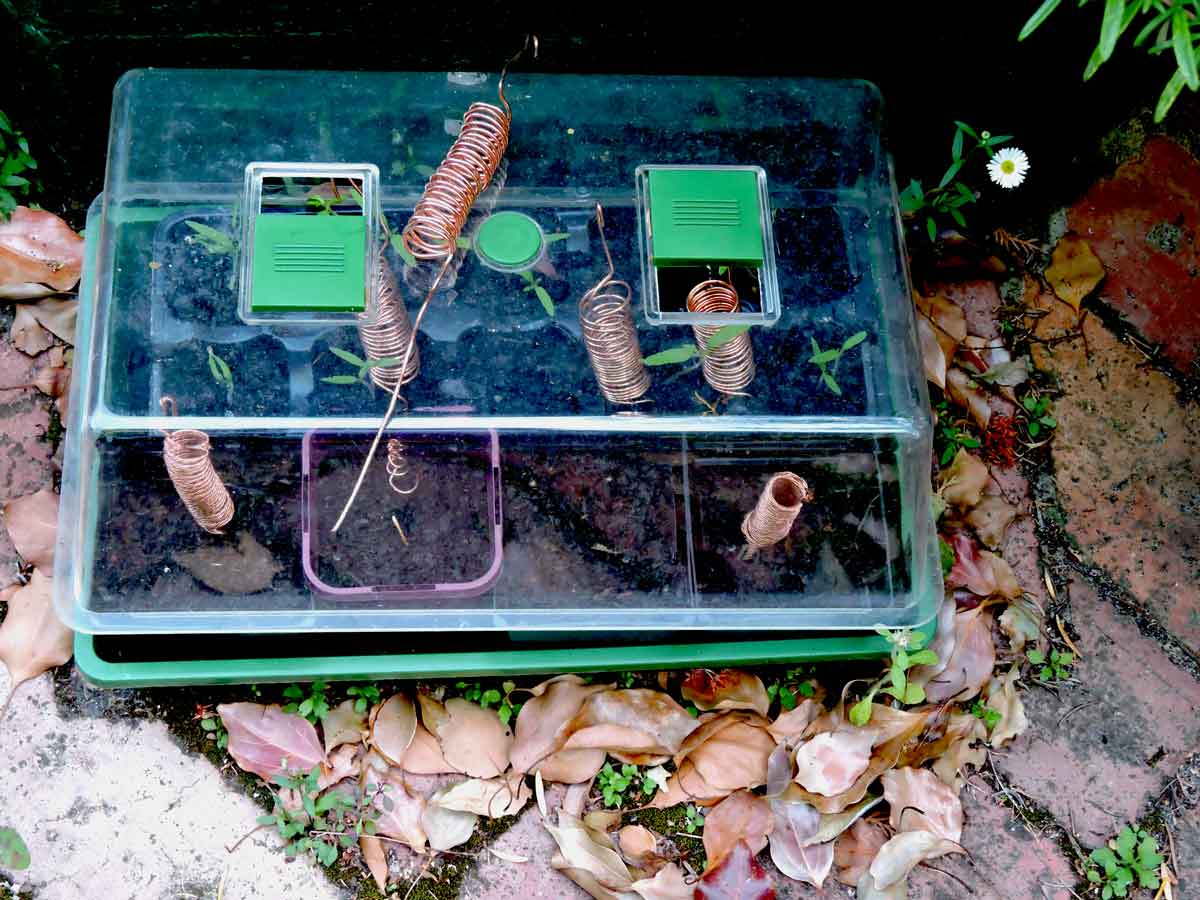



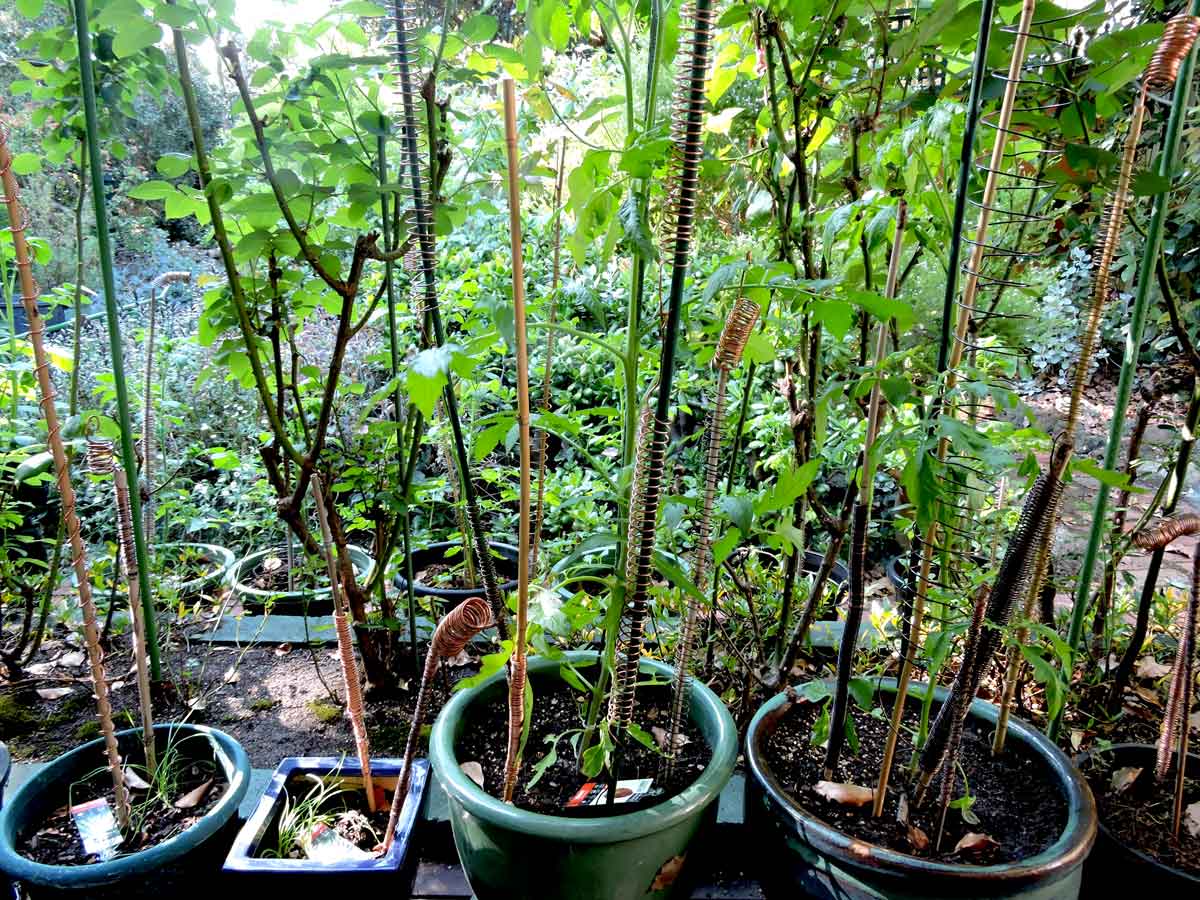


click image to follow link to article
These potatoes doubled in size
over the course of a week!


click image to follow link to article
How I make my 'sticks'
1. Wind copper wire around something to make the coil -
to make like a 'spring'.
2. Leave a good 8-9 inches (12 cm?) each end
3. Make a small 'hook' each end
4. Use bamboo sticks -
slide bamboo stick down middle of 'spring'.
Sticks can vary in length
to suit length of
copper wire you have.
Experiment with different
coil widths and lengths
5. Stretch 'spring' and hook each end
into the hole in the bamboo stick each end
End result -
coil is suspended on stick
with an antenna at one end and a 'leader'
at the other end to slide into soil or pot.
Which way around is anyone's guess right now.
Don't wait for a definitive answer to that -
just do something and see what happens

-0-0-0-0-
This website is always
'work in progress'.
None of the content of this website is original
it is posted here for interest only and should
be considered untruthful and inaccurate until
you've done your own research.
We are not responsible for the accuracy
of any item on this website -
if you choose to accept it and act on it
without doing your own research,
that's down to you.
All content is sourced from that
readily available on the public domain
and does not reflect the views or
opinions of the website creator and should
be viewed critically and considered satire.
While we try to ensure the accuracy of items
mistakes/misinformation/disinformation will
occasionally occur and we invite your corrections.
-0-0-0-0-
Please report broken links
Use the contact form below for messages or
for files or messages by email direct to
email: redpilledtruthers@gmail.com
-0-0-0-0-
Contact Red Pilled Truthers
